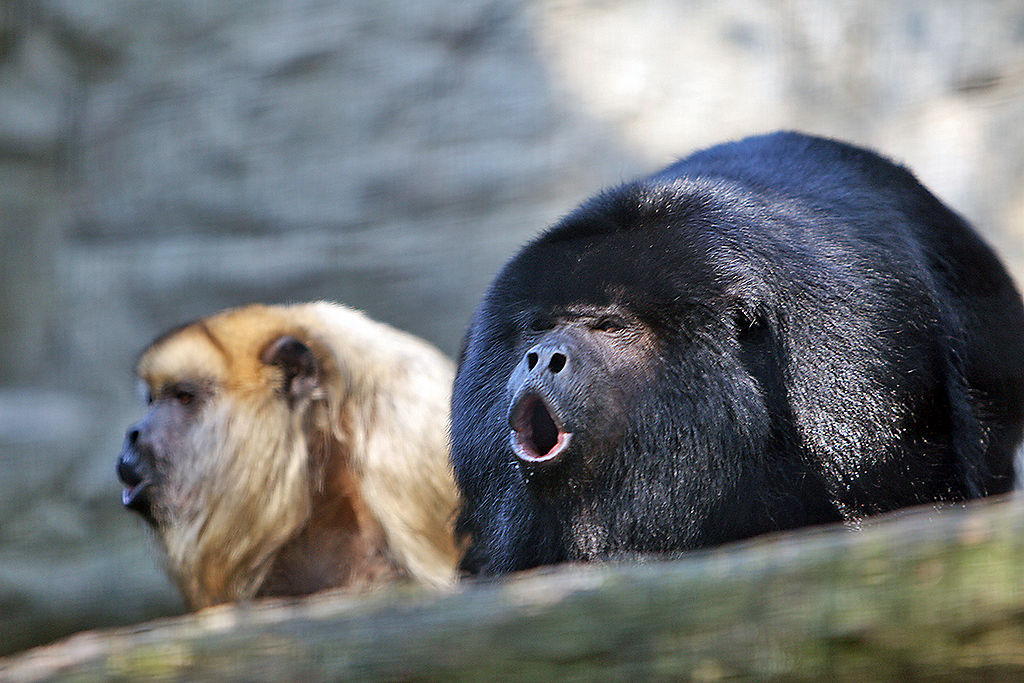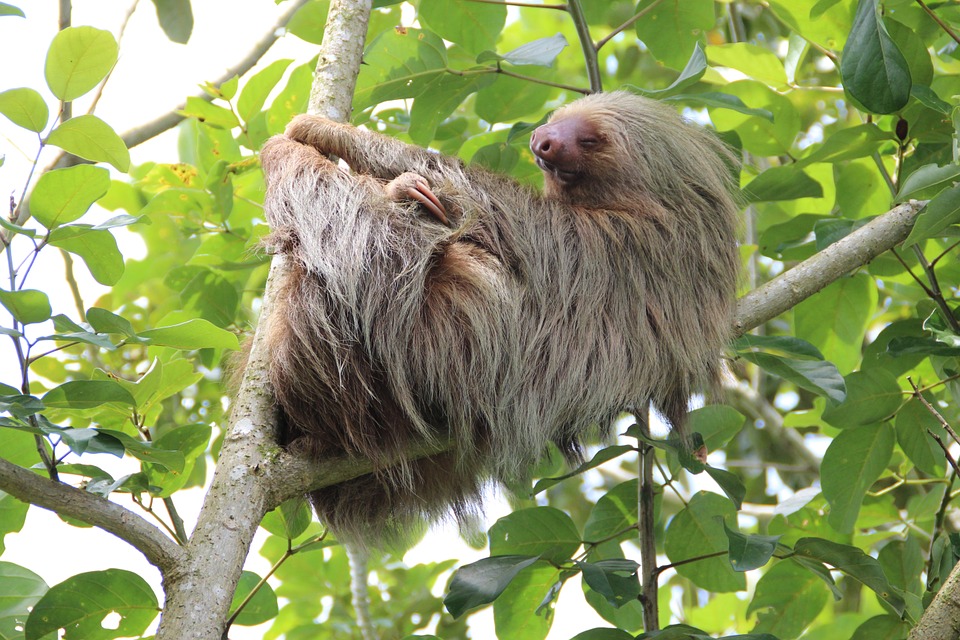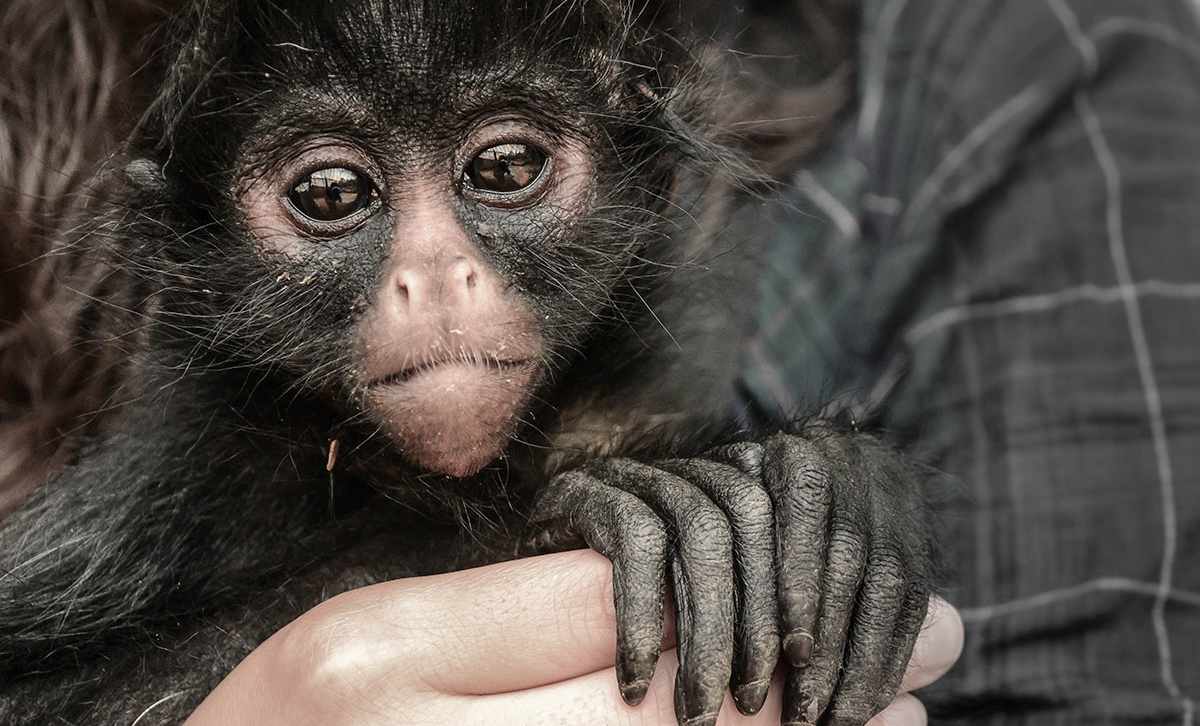Tree-Dwelling Animals of the Amazon Rainforest
Dwelling in the treetops of the Amazon Basin is a completely separate ecosystem compared to the forest floor. Arboreal animals make their habitat in the trees, and have evolved to find their source of food, community and protection among the leaves. There, birds, mammals, primates and insects coexist in an exotic community. This includes new world monkeys, descending from African monkeys 40 million years ago. Loud howler monkeys, slow moving sloths and tiny marmosets are just a few of the arboreal creatures that can be seen in Ecuador’s Amazon Rainforest.
Howler Monkeys

Howler Monkeys Doing What They Do
The first distinctive trait of this species is their LOUD vocal calls. The noise, especially in groups, can be heard up to 3 miles (5km) away, announcing their territory to outsiders. Their appearance when howling is intense, as they lean forward to intimidate their target. Physically, howler monkeys have a commanding presence as well. Their long tail can be 1-5 times their body length, which they use as a tool to grip branches. Building nests in the canopy and feeding mainly on leaves, they rarely come down to the forest floor. Besides, if all of your friends and food are in one place, why would you want to leave?!
Howler monkeys are currently listed as a species of least concern, but they’re facing some serious threats. The main issue is habitat loss due to deforestation, especially in places like the Amazon Rainforest where they live. On top of that, they’re sometimes hunted for meat or captured to be sold as pets, which adds to their troubles. To help them out, we need to focus on protecting their habitats, stopping deforestation, and cracking down on illegal hunting and pet trade. It’s important to make sure they have a safe place to live and thrive in the wild.

Sloth Hanging in the Trees
Sloths
Named after one of the seven deadly sins in English, their name for many Amazonian tribes, Ritto, Rit, Ridette can mean sleep, eat and dirty. Such descriptive names call out quite a few traits of this slow-moving animal. However, each of these names has an opposite benefit that helps them survive in the treetops. Though slow moving, their strength needed to cling upside down from trees is an often-forgotten trait. Similarly, their “lazy,” “sleepy” movements are really just a way to conserve energy. And their fur, though seemingly dirty, is an important habitat for smaller insects and organisms. This distinctive animal is popular among humans because of their multi-dimensional characteristics. Plus, they always seem to be wearing a smile.
Sloths, similarly designated as a species of least concern, confront comparable challenges to howler monkeys, particularly regarding habitat loss stemming from deforestation in the Amazon and other regions where they reside. Additionally, sloths are sometimes sought after for consumption or captured for the pet trade, further exacerbating their conservation status. Protecting sloths entails safeguarding their habitats, halting deforestation practices, and implementing measures to prevent illegal hunting and trafficking. Given their sluggish yet vital role in their ecosystems, preserving sloths is imperative for maintaining biodiversity and ecosystem health.
Marmosets

A Nimble Marmoset
The world’s smallest monkey, marmosets are distinctive because of their tiny body and long tail. They’re so tiny that many pictures show them being held by a human hand for size. Living in the upper forest canopy, their active movements are quick and jerky as they move from tree to tree. Their social structure is cooperative within the family group, as they share care of children and food resources.
Similar to the above critters, they also face population loss. The endangerment of marmoset monkeys in the Amazon is a result of habitat destruction, driven by deforestation for agriculture and infrastructure, which fragments their forest homes and disrupts their specialized needs. Illegal pet trade also poses a significant threat, subjecting marmosets to cruelty and improper care. Climate change exacerbates their plight by altering ecosystems and food availability. Conservation efforts focusing on habitat preservation, anti-poaching measures, and community education are crucial for ensuring their survival and preserving the biodiversity of the Amazon.
Ecological Impact of Losing Amazon’s Keystone Species
The disappearance of howler monkeys, sloths, and marmosets would trigger significant ecological repercussions throughout the Amazon Rainforest and beyond. These animals serve as vital components of their ecosystems, with roles ranging from seed dispersal to providing habitats for diverse organisms. Howler monkeys and sloths, in particular, play crucial roles in seed dispersal, distributing seeds across the forest as they move and feed. Additionally, sloths, with their algae-covered fur, create habitats for various organisms within the canopy. The loss of these species would disrupt plant regeneration processes and diminish biodiversity levels.
Howler monkeys, sloths, and marmosets are integral parts of predator-prey relationships, serving as prey for larger predators such as big cats and birds of prey. Their absence could destabilize predator populations and lead to imbalances within the food web. Furthermore, these animals contribute to ecotourism and scientific research, attracting visitors to the rainforest and providing valuable insights into tropical ecosystem dynamics. Protecting these species is paramount not only for their intrinsic value but also for maintaining the health and resilience of the Amazon Rainforest ecosystem as a whole.
Here’s something you may not know, the marmosets have a cameo in Shakespeare’s Tempest:
“And I with my long nails will dig thee pignuts,
Show thee a jay’s nest, and instruct thee how
To snare the nimble marmoset. I’ll bring thee
To clustering filberts, and sometimes I’ll get thee
Young scamels from the rock. Wilt thou go with me?”
Wilt Thou Go (to the Amazon) With Us?
On Gondwana’s Amazon Awakening tour, guests have the opportunity to go on several hikes in the Amazon Basin with local trained naturalists. Having these guides gives great insight to the rainforest’s biodiversity, both on the canopy and the forest floor. Seeing these exotic arboreal creatures will be an otherworldly experience.
Learn about the Indigenous people of the Amazon and the deep understanding of their rainforest home, utilizing traditional knowledge to thrive in harmony with nature. Their rich cultures and diverse languages contribute to the vibrant tapestry of the region, reflecting centuries of resilience and adaptation. Despite facing challenges such as deforestation and encroachment on their lands, these Indigenous communities continue to assert their rights and advocate for the protection of their ancestral territories.



